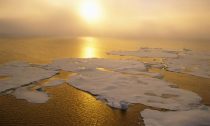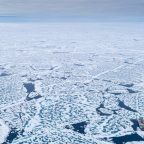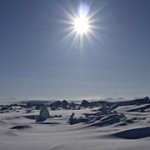
Last week, nine countries—the U.S., Canada, Russia, Norway, Greenland/Denmark, China, Japan, Iceland, South Korea, and the European Union (which includes 28 member states)—agreed to hold off on allowing commercial fishing in the high seas of the Arctic Ocean for at least 16 years while scientists study the potential impacts on wildlife in the far north. It was an extraordinary act of conservation—the rare case where major governments around the world decided to proceed with caution before racing into a new frontier to haul up sea life with boats and nets. They set aside 1.1 million square miles of ocean, an area larger than the Mediterranean Sea.
But to really grasp the significance of this milestone, consider why such a step was even possible, and what that says about our world today. For more than 100,000 years the central Arctic Ocean has been so thoroughly covered in ice that the very idea of fishing would have seemed ludicrous.
That remained true as recently as 20 years ago. But as human fossil-fuel emissions warmed the globe, the top of the world has melted faster than almost everywhere else. Now, in some years, up to 40 percent of the central Arctic Ocean—the area outside each surrounding nation’s 200-nautical-mile exclusive economic zone—is open water in summer. That hasn’t yet been enough to make fishing attractive. But it is enough to make clear that boats may be lured in soon.
So, for perhaps the first time in human history, the nations of the world set aside and protected fishing habitat that, essentially, does not even yet exist. The foresight is certainly something to applaud. But it’s hard to escape the fact that the international accord is also a tacit acknowledgment—including by the United States, which is moving to back out of the Paris climate accords—that we are headed, quite literally, into uncharted waters.
“The Arctic is in a transient state—it’s not stable,” says Rafe Pomerance, a former State Department official who once worked on Arctic issues and now chairs a network of Arctic scientists from nongovernmental organizations and serves on the polar research board of the National Academy of Sciences.
“It’s warming so rapidly that anything we see going on in fisheries today or even four or five years from now may not still be going on there 10 years from now,” says Pomerance. “The Arctic we see today, even though it’s radically different than it was 20 years ago, is going to be even more different in 20 years.”
For the moment, at least, we can’t even say what that means.
No one currently fishes commercially in the high seas of the Arctic Ocean. In part that’s because no one knows what’s there. Knowledge about that region is, one researcher says, “shockingly anecdotal.”
“We simply don’t have that information,” says Nadia Bouffard, director general for the Department of Fisheries and Oceans in Ottawa, and the head of the Canadian delegation that negotiated the fishing ban. “We did pose that question to our scientists. They reported to us is that there is no fish-specific information available for the high seas.”
The sub-Arctic Bering Sea supports the U.S.’s biggest commercial fishing fleets, catching Pacific cod, mackerel, king and snow crab, flatfish and salmon. The $1 billion Alaska walleye pollock fishery, caught for McDonald’s fish sandwiches and many frozen fish sticks, is the most valuable in America. Some species like salmon and many flatfish are clearly moving poleward, seeking the cold waters they’re rapidly losing. Others are not.
The Arctic itself is also home to at least two species of cod—oily rich arctic cod, which is more similar to herring than massive Atlantic cod; and the slightly bigger saffron cod. Cod are key to life in the Arctic, playing an enormous role in the food web. Much of life depends on those fish, from sea birds, narwhals and beluga, to the seals eaten by polar bears.
“I’ve heard scientists joke that polar bears really are nothing more than reprocessed arctic cod,” says David Benton, a former fishing industry representative who now sits on the U.S. Arctic Research Commission.
Researchers have spent years gathering information about ice and plankton as well as walrus, whales, bears, and other mammals. Many of those creatures already face stress from Arctic change, suffering from lack of food and increases in disease. The problem is “we know a lot about the things that fish eat, and the things that eat fish—but little about the fish themselves,” Benton says.
But fishing experts knew it was only a matter of time before some country saw the rich potential and set out with trawl nets to figure it out. In fact, the roots of this agreement can be found almost a decade ago in Alaska’s fishing industry—and its Republican backers. Those groups accepted the truth of what climate change may soon bring even as many in their political party refused then, as now, to acknowledge its very existence.
In 2008, Alaska Sen. Ted Stevens and U.S. Rep. Lisa Murkowski sponsored a resolution calling on the United States to pursue an international treaty to manage fishing in the high seas of the rapidly melting Arctic before any fishing nation rushes in and destroys this marine world. The two GOP politicians, as well as environmental groups and Alaska natives, recognized two important facts—climate change was real and opening the seas quickly; and it would be far too easy to see a rapid collapse of Arctic fish stocks. They knew this because they’d seen it before.
In the mid-1980s, after the U.S. kicked out foreign fleets that had been catching millions of tons of fish from just offshore of Alaska, some in the industry started to worry that those fleets had simply moved to the open ocean. Sure enough, fishing boats from Japan and other nations were catching pollock in the Bering Sea “donut hole,” the circle of high seas not within the jurisdiction of any nation. By the early 1990s, the pollock fishery completely bottomed out, falling from an annual high of 1.5 million metric tons to just 10,000 tons in less than three years. It is considered one of the worst fisheries collapses in history.
“You could see a situation arising where somebody gets feisty and sends a fleet up there to start poking around,” Benton says. “Pretty quickly, they could do significant damage.”
So, spurred on by environmental groups and the Pew Charitable Trusts, the U.S. over the past decade pushed to bring countries to the table. It started with the coastal Arctic nations—Canada, Russia, Norway, the U.S. and Greenland, which is part of the Kingdom of Denmark. Some parties initially were skeptical, but no country wanted another to get there first and wipe out fish stocks for everyone.
But it was also important to rope in other major fishing nations, including China, Japan, the E.U., Iceland and South Korea. If those countries weren’t party to an agreement, nothing would have prevented them from heading into the Arctic over the objections of Arctic nations.
Bill Gibbons-Fly, director of the State Department’s office of marine conservation, led the U.S. negotiations. Some countries were more interested in Arctic conservation, others in a future that included fishing. Some wanted the region off limits for many decades, others just a few years.
Ultimately, the parties agreed that they would embark on a joint scientific program to investigate the Arctic marine system. They would meet every two years to share information. And fishing would be banned outright for 16 years. Any country along the way could seek to begin an orderly move toward commercial fishing. But all decisions, under the agreement, will be made by consensus.
“That’s a big deal,” says Scott Highleyman, vice president for conservation programs at the Ocean Conservancy, who worked on the negotiations from the U.S. side. “That gives any single country the ability to block such a move.”
On the flip side, at the end of 16 years, the ban will continue for another five—unless any party objects.
The agreement must still be signed by all parties, though Gibbons-Fly says he does not foresee major challenges. There’s also no telling how long fishing will ultimately be banned. By some estimates Arctic sea ice could be completely gone in summer well before those 16 years are up.
And no one knows at this point how the world will look then.
“This is the first high seas area in the world that I know of where we’ve decided to send in scientists before fishing boats—that’s the positive news,” says Highleyman. “The pessimistic part is that we’re only talking about this at all because the Artic is changing so fast. That’s scary.”














Social Profiles